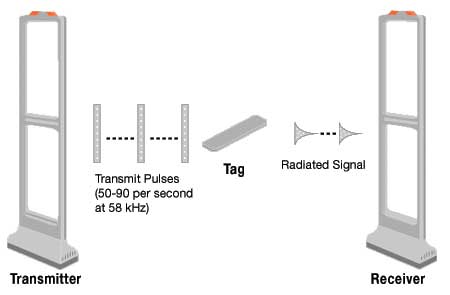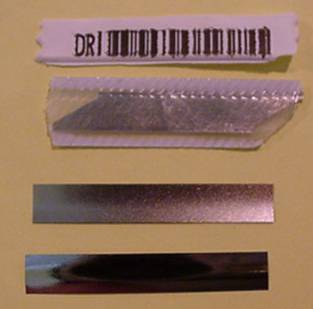How Anti-shoplifting Devices Work (6)

Acousto-magnetic System
The newer acousto-magnetic system, which has the ability to protect wide exits and allows for high-speed label application, uses a transmitter to create a surveillance area where tags and labels are detected. The transmitter sends a radio frequency signal (of about 58 kHz) in pulses, which energize a tag in the surveillance zone. When the pulse ends, the tag responds, emitting a single frequency signal like a tuning fork. While the transmitter is off between pulses, the tag signal is detected by a receiver. A microcomputer checks the tag signal detected by the receiver to ensure it is at the right frequency, is time-synchronized to the transmitter, at the proper level and at the correct repetition rate. If all these criteria are met, the alarm occurs.
AM material is highly magnetostrictive, which means that when you put the tag material in a magnetic field, it physically shrinks. The higher the magnetic field strength the smaller the metal becomes. The metal actually shrinks about one-thousandth of an inch over its full 1.50 inch length.
As a result of driving the tag with a magnetic field, the tag is physically getting smaller and larger. So if it is driven at a mechanically resonant frequency, it works like a tuning fork, absorbing energy and beginning to ring.

Acousto-magnetic System
This tag also requires bias magnet material in addition to active element material. The active material will shrink no matter which direction the magnetic field is placed upon it. If the tag is driven with Frequency, F, it gets smaller as the magnetic field increases and larger as it’s driven towards zero. This means that while it is being driven at F, the tag is trying to work at 2F, because at both positive and negative halves of the drive signal, the tag is getting smaller. To get the tag to work at F, a bias field is required. The bias is provided by a semi-hard magnetic element in the label. When magnetized, the bias prevents the active element from ever being in a zero field condition. So for an entire half of the drive signal, the tag shrinks. Then it expands for the other half. This results in an F response.
When you walk through the gate with a tag, the transmitter in the gate energizes the material and causes it to resonate at F. The transmitter then stops. The tag will continue to “ring” at F for a short period of time, and the receiver listens for that frequency. If it hears it, it knows there is a tag and sounds the alarm.
When the AM tag is demagnetized, it is deactivated. When it’s magnetized, it is activated. (This is the opposite of how the deactivation of EM tags works.)

A typical AM tag from Wal-Mart
(Home Depot began using acousto-magnetic tags from Sensormatic Electronics Corp. because the tags work well when they’re close to metal and the stores use metal shopping carts — not all systems work well with metal objects.)
Other EAS technologies include the microwave system, one of the oldest anti-shoplifting systems and judged by experts to be only about 80 percent accurate, is still around in some stores. Security experts also caution retailers that this system is not compatible with increasingly popular source tagging options. (We’ll discuss source tagging more later!)
